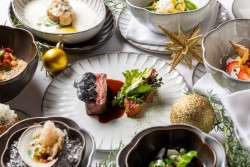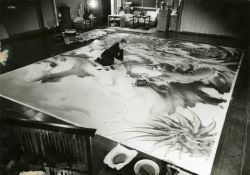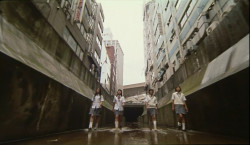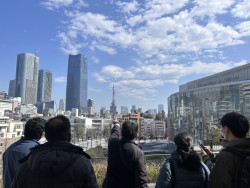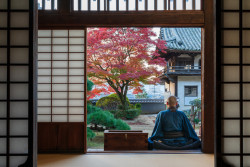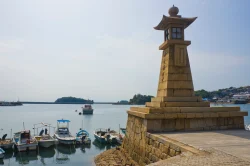
October 10, 2013
God of Fire
There’s more to Narita than just the airport—discover how a visit to the city’s famous temple can make your world a more contented place
By Metropolis
Originally published on metropolis.co.jp on October 2013

Wish upon Narita San

In the late 1600s, Ichikawa Danjuro I, one of the most influential actors of the golden age of kabuki, desperately hoped for a son to carry on his family name. But as time passed and his wish didn’t come true, the devout Buddhist turned to Ofudo-sama (“God of Fire”), the main deity at Narita-san Shinshoji temple, to pray for an heir. Miraculously, his prayer was answered and Ichikawa Danjuro II—who would later become revered as “Narita Fudo’s Heaven-Sent Child”—was born not long afterwards.
To show his gratitude to the divinity, Danjuro I staged the play Tsuwamono Kongen Soga (“Origin of the Soga Warrior”) together with his son. It was the first work in the kabuki tradition to be themed around the Ofudo-sama. The play was a huge hit. Believing the deity to have blessed them with such success, the family felt even more indebted to Ofudo-sama, pledging to visit and support the temple from thereon.
So began the Ichikawa family’s long-standing ties with Narita-san, a relationship that has brought much fulfillment to the family (each generation since has been blessed with an heir) and helped to make the temple one of Japan’s most famous and popular spiritual destinations. Danjuro I’s wide popularity and his attachment to Ofudo-sama prompted many people from across Japan to make regular pilgrimages to the temple.

Today, the God of Fire is still very much worshipped and relied on to make wishes come true and troubles disappear. Visitors can take part in the Ogoma Kito prayer, a daily tradition that began when the temple was founded in 940AD and has the purpose of calling on the deity to fulfill your prayers. Kneeling on the temple’s lush red carpet, beneath the spectacular gold structure that hangs from the ceiling, and listening to the monks chanting the Chorus of Mantras is moving enough to make even the most skeptical of souls whisper their heart’s desire.


There is something undeniably beautiful and comforting about age-old traditions. And when you visit Narita-san, where custom and history are as vivid as the orange fire lit during the Ogoma ceremony, this feeling is accented by the natural beauty of its grounds. Be sure to explore a little, taking in the exquisite three-storied Pagoda, the Calligraphy Museum, and the 165,000 sqm Naritasan Park, which features Japanese apricot and cherry blossom trees, a swan-filled pond and a peaceful waterfall. Pick up an omamori (protective charm) from one of the souvenir shops for an extra dose of luck and fortune. Just remember, its blessing only lasts one year, so you’ll need to return it to the temple after that and make a new wish.
When you reach the Great Pagoda of Peace, don’t be deterred by the steep run of steps leading up to its entrance. It’s worth the climb, for inside this incredibly pretty green-and-red pagoda, which stands tall atop a grassy hill, you can experience yet another wonderful Japanese tradition: shakyo, or sutra copying. This form of meditation is similar to the practice of chanting in that it is said to bring the practitioner peace of mind. As you sit in silence and trace words from the Buddhist scriptures using a delicate feather-tip pen dipped in ink, your body and mind are said to harmonize, thus allowing you to achieve a state of “nothingness.”
Even if you only choose the short ten-letter sutra of Gohogo, the simple yet intricate practice allows you a moment of rest and distance from your mind’s racing thoughts. So by the time you’re ready to leave the temple and stroll through the city’s colorful Omotesando street, where unagi, sake and sweets shops await, life should feel just that little bit calmer.
Narita san: 1 Narita, Narita-shi, Chiba.

A Taste of Narita
Narita’s Omotesando street is dotted with tradition and flavor
Unagi Energy

Back in the Edo period, people regularly embarked on pilgrimages from Tokyo to Narita-san temple. The 64km journey would take them two to three days on foot, so by the time they arrived at their destination they welcomed a nutritious, energizing meal. Narita lodge owners quickly caught on and began serving unagi, a delicious eel dish that has since become one of the city’s major draws.
The freshwater fish is sourced from Tonegawa and Inbanuma fisheries and packed with vitamins A and E. It is served grilled with a subtly sweet barbecue sauce and on a bed of white rice in a bento box. Add a sprinkling of herbs just before you dig in and the melt-in-your-mouth fish will top your list of sensational meals in Japan.
Today there are about 60 unagi restaurants dotting Omotesando street, the one-kilometer path that leads visitors directly from the train station to the temple gates. At some of these restaurants you can actually watch as the fresh eel is prepared and grilled. It doesn’t get more authentic than this.
Sweet Surrender

No daytrip in Japan would be complete without the delightful taste of traditional yokan, and in Narita City the sweet azuki bean jelly treat is a must—for both yourself and as a souvenir gift for friends. The recipe is said to have been inspired by the type of vegetarian food eaten by the monks at Narita-san temple and, like unagi, was popular among the pilgrims as they completed their long journey from Tokyo to the temple. For deeper insight into the origins and history of this unique dessert, visit the Narita Yokan Museum, which you’ll find behind a large yokan store, Nagomi no Yoneya, as you make your way to the top of Ometesando street towards the station.
Yokan’s superior sweetness and rich taste has made it one of Narita’s most loved products, with the most popular variation being the very original recipe—a chestnut-filled jelly sweet. You couldn’t ask for a sweeter denouement as your day in Narita comes to a close.
Nagomi no Yoneya: 500 Kamicho, Narita-shi, Chiba.
Sake Dream

At the end of the Edo period, nihonshu (rice wine) maker Takizawa Honten paid a visit to Narita-san. While there, one night he dreamt of the deity Ofudo-sama and awoke with a revelation: he would establish a sake brewery in Narita City. He did just that in 1872 and the superb quality of his pure well water gained a reputation, with some visitors even claiming that it had cured them of their ailments. As a result, Honten’s sake, made from the renowned well water, became known as Chomeisen, which means giving long life and spiritual power.
The brewery and store are still there today and, after a satisfying unagi meal, a little sake tasting wouldn’t go amiss. You can visit the brewery itself to learn more about how exactly rice is fermented and then combined with a microorganism called koji and yeast to make the unique alcohol. You can visit any time between December and February but you need a reservation.
Another Narita-based sake maker, Nabedana, also began brewing the alcohol because of the area’s high quality of water. Unfortunately, their brewery was moved out of town but you can still visit the store, just next to Narita-san’s main Somon gate. Be sure to taste the refined sake brands Jinyu, Fudo and Tsugumi.
Sake is classified into four general categories: flavorful, light and smooth, rich and aged. With plenty of different brands on offer at the sake stores on Omotesando street, you’ll be treated to a wide variety of tastes. And with Narita being known for its quality spring water, you’ll be enjoying a quality tipple, too. Kampai!
Takizawa Honten: 540 Kamicho, Narita-shi, Chiba
Nabeyagengoemon: 338 Honcho, Narita-shi, Chiba
HOTELS IN NARITA CITY
ANA Crowne Plaza Narita
Tel: 0476-33-1311 Address: 68 Horinouchi, Narita-shi, Chiba
APA Hotels & Resorts
Tel: 0476-20-3111 Address: 906 Hanazakicho, Narita-shi, Chiba
Hilton Narita
Tel: 0476-33-1121 Address: 456 Kosuge, Narita-shi, Chiba
Hotel Nikko Narita
Tel: 0476-32-0032 Address: 500 Tokko, Narita-shi, Chiba
International Garden Hotel Narita
Tel: 0476-23-5522 Address: 241-1 Yoshikura, Narita-shi, Chiba
Marroad International Hotel Narita
Tel: 0476-30-2222 Address: 63-1 Komaino, Narita-shi, Chiba
Mercure Narita
Tel: 0476-23-7000 Address: 818-1 Hanazakicho, Narita-shi, Chiba
Narita Airport Rest House
Tel: 0476-32-1212 Address: Narita International Airport Narita-shi, Chiba
Narita Excel Hotel Tokyu
Tel: 0476-33-0109 Address: 31 Oyama, Narita-shi, Chiba
Narita Gateway Hotel
Tel: 0476-35-5511 Address: 658 Oyama, Narita-shi, Chiba
Narita Higashiya Hotel
Tel: 0476-22-8171 Address: 92-2 Azumacho, Narita-shi, Chiba
Narita Kikusui Hotel
Tel: 0476-23-2300 Address: 168-1 Azumacho, Narita-shi, Chiba
Narita Tobu Hotel Airport
Tel: 0476-32-1234 Address: 320-1 Tokko, Narita-shi, Chiba
Narita U-city Hotel
Tel: 0476-24-0101 Address: 1-1-2 Igodai, Narita-shi, Chiba
Narita View Hotel
Tel: 0476-32-1111 Address: 700 Kosuge, Narita-shi, Chiba
Naritasan Monzen Ryokan Wakamatsu Honten
Tel: 0476-22-1136 Address: 355 Honcho, Narita-shi, Chiba
Radisson Hotel Narita
Tel: 0476-93-1234 Address: 650-35 Nanae, Tomisato-shi, Chiba
Richmond Hotel Narita
Tel: 0476-24-6660 Address: 970 Hanazakicho, Narita-shi, Chiba
Toyoko Inn Narita Kuko
Tel: 0476-33-0451 Address: 560 Tokko, Narita-shi, Chiba
For more information, visit Feel Narita’s website.


